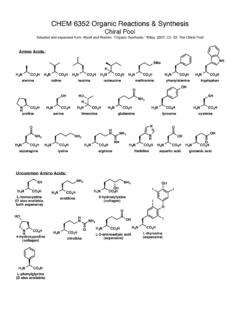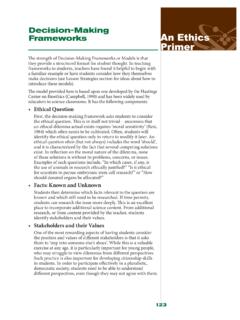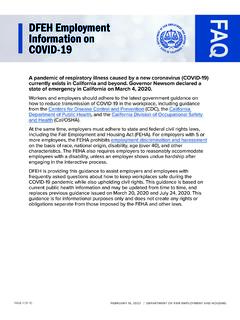Transcription of Protecting Groups Handout A - University of Houston
1 Chem 6352 Protecting GroupsHydroxyl ProtectionMethyl EthersFormation:Stability: :Methyl ethers, with the exception of aryl methyl ethers, are often difficult to remove. However, there are , EtSH PhSe-Ph2P-Me3 SiIStable to Acid and BaseCH2N2, SiO2 or HBF4 NaH, MeI, THFM ethylthiomethyl Ethers (MTM)Formation:Stability:Cleavage:MeSCH2 Cl, NaH, THFS table to base and mild acidHgCl2, CH3CN, H2 OAgNO3, THF, H2O, baseOHOMeOOOMeOBzAlBr3, EtSHOOOHOBzTL 1987, 28, :TheMTMgroupisanicesubstitutedmethylethe rprotecting group that can be removed under neutral conditions employing the indicated of 1,2- and 1,3-diolsTrityl EthersFormation:Stability.
2 The trityl group usually goes on and comes off easily. In addition,itsstericbulkallowsforgoodselec tivityinprotecting primary over secondary Acid (formic or acetic)Stable to BasePh3 CCl, pyridine, DMAPPh3C+BF4-Isopropylidene ( acetonide)Formation:Stability:Cleavage:2 ,2-dimethoxy propane or 2-methoxy propene and cat. acidStable to basecat. Camphor Sulfonic Acid (CSA) and :Theacetonideiscommonlyusedtoprotect1,2- and1,3-diols. It forms readily and is easily removed. Generally, the acetonide will form a dioxolane selectively over a ,2-and1,3-diols(formingeitherthedioxolan e or dioxane, respectively) are often referred to (PREFIX)ylidenes, where the prefix depends on the nature of R and :Stability: :Similar to acetonidescat.
3 Camphor Sulfonic Acid (CSA) and MeOHStable to BaseCorresponding ketone or dimethyl acetal and acid catalystBenzylideneFormation:Stability:C leavage:PhCHO, H+, H2O removalPhCH(OMe)2, H+Stable to basecat. Camphor Sulfonic Acid (CSA) and MeOHH2, :The benzylidenes are readily formed; in competition between 1,2- and 1,3-diols they will generally form the dioxane. Hydrogenolysis provides a nice orthogonal mode of deprotection. However, benzylidenes are usually hydrogenolyzed more slowly than benzyl ethers or BenzylideneFormation:See benzylidenesOHR1 RHOOORR1 OMe BENZYLIDENE CONTINUED ON NEXT PAGES tability: can undergo a variety of interesting transformations, for example:AcOH, H2 OCANS table to BaseOOOHOOMeHOPhHNBS, CCl4 OOHOOMeHOOPhBrOrg.
4 Syn. 1987, 65, 243 OOMeO2 CCO2 MePhNa(CN)BH3 TiCl4, CH3 CNMeO2 CCO2 MeOHOHS ynthesis 1988, 373 OOOOPhTMS-CNBF3 OEt2 OOOHOMeOMeOPhCNTetrahedron 1985, 41, 3867 OOPhDIBALOBnOHOOMeOOMeTL 1988, 29, 4085 CarbonatesFormation:Stability: :Carbonates are generally easy to put on and take off and provideniceorthogonalitytothenumerousaci dlabileprotecting Groups for 1,2- and 1, removed with -OH or -HStable to BasePhosgene, pyridineTriphosgene, pyridineCarbonyl diimidazoleOHR1 RHOOORR1 OProtecting Groups for Ketones and AldehydesFormation:Stability:Cleavage:St able to baseAcetals are generally removed with H3O+.
5 Cleavage rates of1,3-dioxaneshavebeenstudied(ChemRev196 7,67,427) and , -unsaturatedcarbonylsformacetalsmuchslow er than their saturated counter parts, and often result in olefin and ketones are most often protected as cyclic and acyclic , H+R1 ROMeOMeR1 RCH2(CH2OH)2H+, PhH, -H2OR1 ROOOOTL 1988, 29, 4085(CH2OH)2, H+PhH, -H2O-or-(CH2 OSiMe3)2 TMS-OTf, CH2Cl2R1 ROOR1 ROOR1 ROO>>>OOCH2(CH2OH)2H+, PhH, -H2 OOOOS tability:Fisher esterification (RCOOH + R'OH + H+)Acid chloride + ROH, pyridinet-Butyl esters: isobutylene, H+Methyl esters: diazomethaneCarboxylic Acid ProtectionFormation:Cleavage:t-Butyl: cleaved by moderately acidic hydrolysisOthers: LiOH, THF, H2O enzymatic hydrolysist-Butyl: stable to mild base and ammoniaOthers: stable to acid9-Fluorenylmethyl Esters (Fm)Stability:Cleavage:Fm is stable to acidFm is cleaved by mild base (Et2NH)Alkyl EstersROHOROR'OCO2 MeMeO2 COHPig Liver EsterasepH bufferCO2 HMeO2 COHR eview.
6 Org Reactions 1989, 37, 1 RCO2 HOHDCCOORTL 1983, 24, 281 Note that DCC coupling proceeds as follows:ROONCNHROONHNC6H11C6H11 ROROROHNHONHC6H11C6H112-(Trimethylsilyl) ethoxymethyl Esters (SEM)Stability:Cleavage:SEM is removed with fluoride ( TBAF in DMF)Stable to Acid2-(Trimethylsilyl)ethyl EstersBenzyl EstersHelv Chim Acta 1977, 60, 2711 RCO2 HOHOSiMe3 OOSiMe3 RORCO2 HHOSiMe3 ORSiMe3 JACS 1984,106, 3030 ODCCDCCS tability:Cleavage:SEM is removed with fluoride ( TBAF in DMF)Stable to Acid2,2,2-Trichloroethyl EsterRCO2 HHOCCl3 ORCCl3 JACS 1966, 88, 852 ODCCS tability:Cleavage:Zn, AcOHStable to AcidROClHOPhEt3N, DMAPCH2Cl2, 0 CROOPhNote: DMAP = 4-dimethylamino pyridineROClNNNNRONNROFor a review of 4-dialkylaminopyridines see ACIEE 1978, 17, 569 Stability:Cleavage:HydrogenolysisNa, NH3 Stable to AcidFormation:Acid Chloride and benzyl alcohol (see above)o-Nitrobenzyl estersStability:Cleavage.
7 Can be cleaved by photolysissee BenzylOrthoestersSynth 1980, 1TL 1983, 24, 5571 Stability:Cleavage:Removed with mild acidStable to Base!Formation:see BenzylFormation:See above reactionRCOClOOHROOOBF3 OEt2 OOROROONO2 Stability:As aboveProtection of Amines9-Fluorenylmethyl carbamate (FMOC)Formation:Cleavage:Removed with amine base: Et2N, piperidine, to acid2,2,2-Trichloroethyl Carbamate (TROC)Acc Chem Res 1987, 20, 401R2 NHOOONR2 OClNaHCO3H2O, dioxaneCl3 COClOR2NH, pyridineCl3 CONR2 OStability:As aboveFormation:Cleavage:Zn dustStable to mild base and acid2-(Trimethylsilyl)ethyl Carbamate (TEOC)OClOR2NH, pyridineONR2 OStability:As aboveFormation:Cleavage.
8 TBAF or TFAS table to mild base and acidMe3 SiMe3 SiStability:As above (and many others)t-Butyl Carbamate (BOC)Formation:Cleavage:Strong protic acid (TFA or 3M HCl)TMSIS table to baseAllyl Carbamate (ALLOC)TL 1986, 27, 3753R2 NHStability:As above or with Alloc-ClFormation:Cleavage:Removed with Pd(0) and reducing agentStable to mild base and acidBenzyl Carbamate (CBZ)Stability:As aboveFormation:Cleavage:HydrogenolysisPd Cl2, Et2 SiHTMSIBBr3h (254 nm)Na/NH3 Stable to mild base and acidt-BuOOOOt-BuOt-BuONR2OR2 NHONR2 OOOOOOR2 NHONR2 OBnOOClStability:As aboveSulfonamides (Ts, Ms)Formation:Cleavage:Reduction (Mg, NH4Cl, MeOH)For 3-substituted indoles basic hydrolysisUsually stable to acid and baset-BuONR2 ONH2 TsCl, pyrisobutyldi-tert-butylsilyl (BIBS)OL 2011, 13, 4120 Stability:As aboveFormation:Cleavage:Removed fluorideStable to mild base and acidR2 NHSiOTfbaseSiR2N








